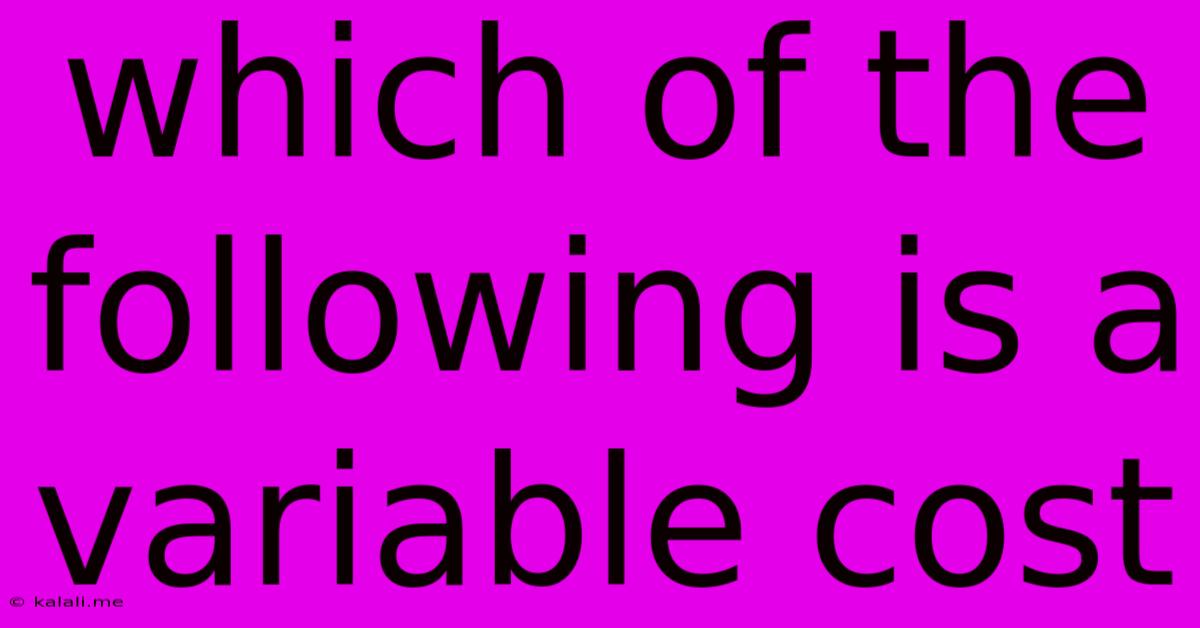Which Of The Following Is A Variable Cost
Kalali
Jun 16, 2025 · 3 min read

Table of Contents
Which of the following is a variable cost? Understanding Variable vs. Fixed Costs
Understanding variable and fixed costs is crucial for effective business management and financial planning. This article will clarify the distinction between these two cost types and provide examples to help you identify variable costs. This knowledge is essential for accurate budgeting, pricing strategies, and profitability analysis.
What is a Variable Cost?
A variable cost is an expense that changes in proportion to the level of goods or services produced by a business. This means that as production increases, so do variable costs, and vice versa. They are directly tied to the output volume. A key characteristic is that variable costs are zero when production is zero. Understanding this helps distinguish them from fixed costs.
Examples of Variable Costs:
-
Direct Materials: The raw materials directly used in the production process. For example, the cost of flour for a bakery, fabric for a clothing manufacturer, or wood for a furniture maker will fluctuate depending on how many loaves, clothes, or pieces of furniture they produce.
-
Direct Labor: The wages paid to workers directly involved in production. If a factory produces more goods, it will likely require more workers, increasing labor costs. Conversely, reduced production might lead to fewer working hours and lower labor expenses.
-
Sales Commissions: Payments made to sales representatives based on the volume of sales. Higher sales translate into higher commission payouts.
-
Shipping and Delivery Costs: The costs of transporting goods to customers. The more goods shipped, the higher the shipping expenses.
-
Utilities (sometimes): While some utility costs are fixed (like a base electricity charge), others can be variable. For example, the electricity used in a manufacturing plant directly correlates with production levels. High production means higher electricity consumption.
-
Packaging Costs: The cost of materials used to package and prepare products for sale.
Variable Costs vs. Fixed Costs:
It's crucial to contrast variable costs with fixed costs to fully grasp the concept. Fixed costs remain constant regardless of production volume. Examples include rent, insurance premiums, and salaries of administrative staff.
Identifying Variable Costs in a Scenario:
Let's imagine a scenario where you're asked: "Which of the following is a variable cost?" and given options like rent, raw materials, insurance, and employee wages (for production workers). The correct answer would be raw materials and employee wages (for production workers). Rent and insurance are fixed costs.
Why Understanding Variable Costs Matters:
Knowing your variable costs is crucial for:
-
Pricing Decisions: Accurate cost calculation helps set profitable prices.
-
Break-Even Analysis: Determining the production volume required to cover all costs.
-
Profitability Projections: Predicting profits based on different production levels.
-
Cost Control: Identifying areas where cost reduction strategies can be implemented.
-
Budgeting: Creating realistic and accurate financial plans.
By understanding what constitutes a variable cost and how it differs from fixed costs, businesses can make informed decisions that lead to improved profitability and financial stability. Accurate identification and management of variable costs are key to successful business operations.
Latest Posts
Latest Posts
-
How To Create Clickable Image In Html
Jun 16, 2025
-
What Are The Factors Of 121
Jun 16, 2025
-
What Is A Theme Of The Passage
Jun 16, 2025
-
A Company That Provides Access To The Internet
Jun 16, 2025
-
Which Word Is Closest In Meaning To The Underlined Word
Jun 16, 2025
Related Post
Thank you for visiting our website which covers about Which Of The Following Is A Variable Cost . We hope the information provided has been useful to you. Feel free to contact us if you have any questions or need further assistance. See you next time and don't miss to bookmark.